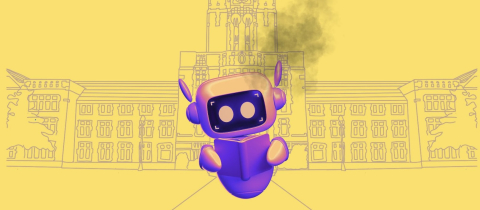You have just been attacked. How likely is it that someone will come to your help?
If you remember the infamous case of Kitty Genovese in 1960s New York, you may despair at ever receiving assistance. Psychology students are diligently taught about this watershed moment; fans of the HBO show Girls were treated to a whole episode about it; and this murder is a core part of the character Rorschach’s origin story in the celebrated graphic novel Watchmen. In the latter, a fictional newspaper headline sums up the tragedy: “WOMAN KILLED WHILE NEIGHBORS LOOK ON.”
The shocking event inspired researchers to look into what would become known as the bystander effect, the idea that an individual is less likely to lend a helping hand when in the company of others. Anonymous in a crowd, we are said to turn a blind eye to an emergency and simply move on.
But the bystander effect is actually more complicated than its mythological version, and it begins with a story that has been distorted beyond recognition—that of the murder of Kitty Genovese herself.
All the news that’s fit to misprint
Warning: what you are about to read is not 100% true.
On March 13th, 1964, a little after 3AM, Catherine Genovese, known as “Kitty,” was returning home from her job as the manager of a bar. She parked her car less than a hundred feet away from the apartment building where she lived in Kew Gardens, a neighbourhood in Queens, New York.
She noticed a man at the far end of the lot where she left her car. She started walking but the man caught up to her and grabbed her. “For more than half an hour,” the New York Times published two weeks after the event, “38 respectable, law-abiding citizens in Queens watched a killer stalk and stab a woman in three separate attacks in Kew Gardens.” Only one of them ended up calling the police, but only after she was already dead.
The killer stabbed her then left after a man shouted from an upper window to leave her alone. He came back and stabbed her again, her screams causing people in neighbouring apartments to turn on the lights. The man once more left the scene, and Ms. Genovese managed to crawl all the way into her apartment building, where the man came in and stabbed her at the foot of the stairwell—fatally, this time.
Strikingly, the man behind the phone call to the police said, “I didn’t want to get involved.”
“Apathy at Stabbing of Queens Woman Shocks Inspector,” read part of The New York Times’ headline, and it shocked the world. Experts hypothesized as to why people had gawked instead of helping her. The zombifying powers of television were denounced; comparisons to Germans during the Holocaust were boldly made; and of course feminism was thrown under the bus for reshaping men from heroes to zeroes. The murder of Kitty Genovese also arrived in a cultural context in which the darker side of humanity was put under a spotlight, with the publication of The Lord of the Flies a decade earlier, the public trial of Holocaust architect Adolf Eichmann, and the coverage of Stanley Milgram’s experiments into “just following orders.”
Far from being benevolent, humans appeared to be nasty brutes or, at the very least, uncaring creatures.
The only problem? The New York Times got it wrong.
The parable of the 38 witnesses
Six days after the murder, a 29-year-old man named Winston Moseley was arrested and charged for the homicide, and his court case, combined with legal documents tracked down by a local historian and lawyer named Joseph De May Jr, revealed a wholly different picture of what went down on March 13th.
Those 38 eyewitnesses? Most of them were not eyewitnesses at all, and the few who had seen something would have been unable to witness the entire attack because of its geography. Moreover, there were only two attacks—one outside and one inside the apartment building—not three. And the cherry on top of the bad-reporting sundae? Kitty Genovese was still alive when the cops arrived, and she wasn’t alone: a friend named Sophia Farrar, upon hearing over the phone what had just happened, rushed to the scene. The killer was gone, but she put her arms around Kitty Genovese, who was still alive, and gave her comfort.
As for the man who didn’t want to get involved, it turns out that he was gay and drunk, and homosexuality was illegal back then. That may be why he ended up climbing over the roof to his next-door neighbour’s house and got the woman there to call the cops instead. And it wasn’t as easy as dialing 911 because 911 wouldn’t exist for another four years—and the murder of Kitty Genovese is said to have sped up the adoption of a central emergency phone number in the United States. Instead, the people of Kew Gardens had to call their local police station, which was not always welcoming of phone calls.
People helped as best they could given what they had managed to witness, but The New York Times ran with a completely fumbled story that perpetrated this myth of urban apathy. Ironically, 52 years later, following the death of Winston Moseley who spent the intervening time behind bars, the famed newspaper revisited its erroneous coverage and still managed to make a mistake, mislabelling the street they showed in an accompanying picture. No wonders the residents of Kew Gardens are sick of people coming in and asking about the murder.
This real-life tragedy has now become a myth, described by one academic paper as The Parable of the 38 Witnesses. When its authors flipped through the 10 most popular textbooks aimed at psychology undergraduate students, they found the story in all of them. Every textbook claimed that nobody intervened and that the cops were called after Kitty Genovese had died, and almost all of them suggested that 38 witnesses had simply watched from their windows as Ms. Genovese was brutally attacked for half an hour.
It's not the only time that psychology textbooks have grossly misrepresented a seminal case study—the Hawthorne effect is commonly distorted as well. Textbooks attempt to simplify, to keep the story simple so as to engage young students, but in this case, they end up potentially betraying the nature of social interactions in an emergency.
Kitty Genovese’s murder inspired researchers to study why people don’t always come to someone’s help, especially when they see other bystanders witnessing the emergency. The effect is real, but there too, there is important complexity.
Laboratory experiments or real-life observations?
Imagine you are participating in a psychological experiment, alone in a room with a headset. You are told you will be speaking about your personal problems with other people, who are sitting in other rooms with their own headsets. You go around the virtual table, chatting for a bit—like a Zoom call with the cameras off—until you hear one of the participants stuttering, asking for help, making choking sounds, and finally spelling it out: “seizure.” What would you do?
Many of these types of laboratory experiments were run in the wake of the Genovese murder, and the number of participants would be changed, from two to three to six. The main participant—the hero, who was being tested, while everyone else including the victim were pre-recorded—was less likely to run out of the room and try to help the more people were listening in. In one such study, the hero would seek help 85% of the time if there were no other witnesses; 62% of the time if they had heard one other participant; and 31% of the time if they had heard four other participants. The more people “on the call,” so to speak, the more passive the hero was likely to act.
This bystander effect was firmly confirmed in 2011 with the publication of a meta-analysis, meaning a study of all available studies, corralling data from 7,700 participants over the course of six decades. But two questions remain: why exactly do people choose not to help when they see other witnesses around, and are those laboratory experiments representative of real-world emergencies?
Trying to probe the human mind and get a truthful answer as to what motivates someone to do or not do something is really hard. Motivation is complex, and the decision to help a stranger is layered. The researchers who began studying the bystander effect, John Darley and Bibb Latané, broke the decision-making process into five steps: you first have to notice that something is happening; then, you must realize that it’s an emergency; you must feel personally responsible for the victim; you must believe you have the skills necessary to help; and finally you need to reach the decision to help them.
Indeed, some of the witnesses to the Kitty Genovese murder could only see two shadowy figures and assumed it was a marital dispute, not a real emergency. If it’s not an emergency, why act? Also, some people might fear being judged for acting publicly, while others will notice bystanders going about their lives and conclude that an ambiguous-looking situation must not be urgent.
Even in those early studies by Darley and Latané, in the shadow of The New York Times pronouncing a deadly wave of urban apathy, the participants who had failed to act when hearing someone apparently having a seizure over their headset were not robots devoid of feelings; they were still in a state of indecision. They hadn’t made up their mind. Some of them told the experimenter they did not want to ruin the experiment, a comment echoed by some of the participants in Stanley Milgram’s infamous studies who kept delivering bigger and bigger electrical shocks to an unseen victim: it’s not that they were insensitive to another human being’s pain, but simply that they didn’t want to mess up an experiment they did not understand.
A few years ago, a completely different study was published that cast all of this carefully controlled laboratory research in a different light. Instead of playing recordings of a person in distress in a room at the local university, these researchers pulled video footage from CCTV cameras in the United Kingdom, South Africa, and the Netherlands, specifically of 219 public conflicts. How often did bystanders intervene? In nine out of 10 conflicts, at least one person, but typically several, would do something to help. On average, they found a little shy of 4 interveners per conflict captured on video. In fact, the more bystanders were present, the greater the chances of the victim receiving help. This is the exact opposite of the bystander effect.
Laboratories will usually simulate one or two other bystanders, but in an urban environment, the reality is that we are surrounded by many people, and we do tend to help out people in need. This strange dichotomy is an extreme example of the problem scientists often face. Do you create a fully artificial situation in order to control as many variables as possible, or do you study what happens in the natural world, even though your data will be full of noise and variables you cannot control? In the lab, we become less helpful the more bystanders we perceive… but in the real world, at least in this one dataset of 219 incidents, we are revealed to be Good Samaritans. I think both types of experiments have their place. Neither explains it all. Human psychology, after all, is quite complex.
Embracing this complexity and avoiding oversimplifications is crucial if we want to truly understand the human mind and the universe around us. I learned about the misreporting on the Kitty Genovese murder from the book Humankind: A Hopeful History by Rutger Bergman. In it, he mentions that a radio reporter at the time found out that The New York Times coverage was wrong. He spoke to their journalist and asked why he didn’t print that the actual eyewitnesses claimed to have simply seen a drunken woman. “It would have ruined the story,” he admitted.
The irony? Winston Moseley, Kitty Genovese’s murderer, was caught when he later tried to steal a television from a house. Who disabled his vehicle to prevent him from escaping and called the cops? A couple of bystanders.
Take-home message:
- The erroneous reporting of the brutal murder of Kitty Genovese in 1964 New York City led to the idea that in cities people will not come to your help in the middle of an emergency
- Ms. Genovese’s murder caused scientists to study the bystander effect, whereby the more witnesses there are to an emergency, the least likely one of them is to help the victim, an effect that has been seen again and again in artificial conditions in a laboratory setting
- When a research team looked at 219 conflicts captured by CCTV cameras in three cities around the world, they found the exact opposite: the more bystanders, the more chances of the victim receiving help, casting doubt on a generalized bystander effect







